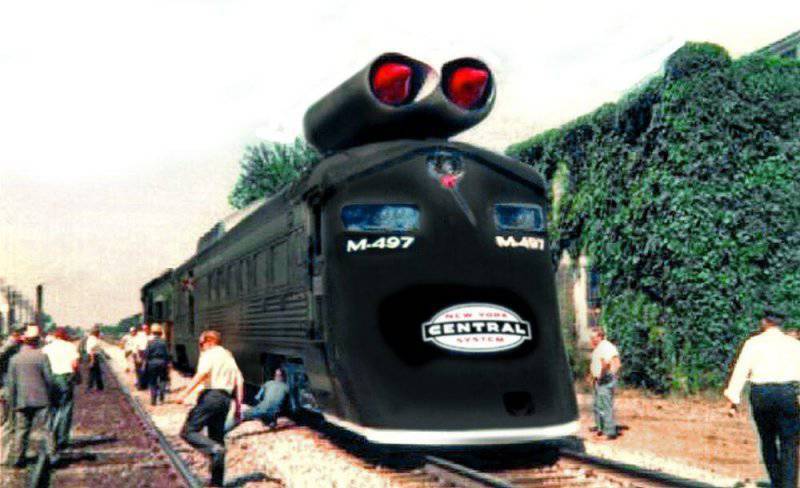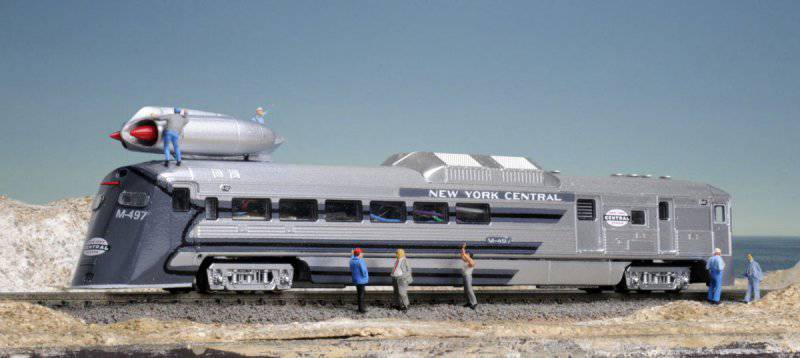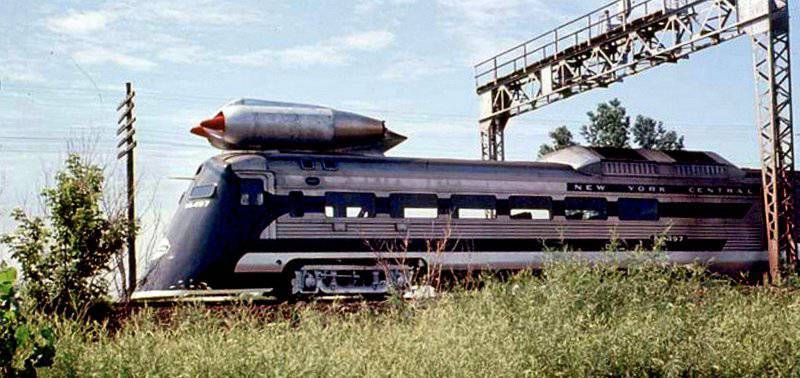Jet Aeronaut M497 Black Beetle (USA)
Perhaps the most interesting way to attract new passengers was proposed by specialists of the New York Central Railroad (NYC). All carriers understood that promising high-speed vehicles were required to restore past volumes. It was suggested to increase the speed of trains in different ways, but the most popular were an increase in engine power, the creation of streamlined bodies and the optimization of the design of equipment. However, more bold ideas were proposed. So, in 1965, engineers Don Wetzel and Hank Morris proposed using units borrowed from airplanes instead of the traditional power plant. So began the project Black Beetle ("Black Beetle" or "Black Cockroach").
Perhaps, Wetzel and Morris knew about the German, Soviet and other aeronautical projects, but their proposal had a serious difference from previous developments in this area. Early aero wagons used a piston motor and a propeller. It was proposed to build a new car in accordance with the spirit of the times and equip it with jet engines. Such a power plant in the future could provide uniquely high speeds. Naturally, the new aircraft could not compete with existing aircraft in speed, but was quite able to press them in some directions.
D. Whetzel and H. Morris made a proposal to the president of NYC, Alfred Perlman. The head of the company became interested in the idea presented and supported the new project. Already in 1965, specialists of the company headed by Wetzel and Morris began preparations for the assembly of an experienced prototype of a prospective air wagon. The preliminary work and the assembly of the prototype took only a few months. Already in 1966, the M497 Black Beetle was ready to begin testing.
In those days, railway companies were experiencing not the best of times, which is why the authors of the Black Beetle project had to save almost everything. Thus, an experienced car was built on the basis of the Budd RDC-3 with the tail number M497, which later became an alternative designation for the project. Two General Electric J47-19 turbojet engines were purchased from the Air Force, which was previously used on a B-36 bomber. Finally, some units of the Black Beetle were made in the workshops of the railway company. A few words should be said about the used M497 base rail. This vehicle was used by New York Central from 1953 onwards and was used to carry passengers between Detroit and Macinos City, after which it was used on New York State lines. In the mid-sixties, the car was sent for repair, from where it returned in a new form and with jet engines.
The RDC-3 railcar is a typical representative of the Budd family of vehicles. This machine had a length of 25,91 m, a width of 3,06 m and a height of 4,45 m. As part of the chassis there were two biaxial bogies with wheels with a diameter of 838 mm. The self-propelled carriage was equipped with two Detroit Diesel 110 diesel engines with a total power of 550 hp. and hydraulic transmissions. The total weight of the car exceeded the 50 t. Inside the RDC-3, there were 48 seats for passengers, a luggage compartment and a compartment for carrying mail.
During the repair and re-equipment of the railcar, the M497 lost a number of units and also received new equipment. A pylon with two General Electric J47-19 turbojet engines, 23 kN, was installed above the crew cabin. To give a recognizable "science fiction" look, the conical central bodies of the air intakes were painted red. Later D. Wetzel recalled that his wife, who worked as an artist, insisted on the front engine layout. She felt that the front location of the power plant would make the aircraft more beautiful, and the ugly cars, as you know, do not work well. The authors of the project did not argue with this proposal.
For some improvement in aerodynamics at high speeds, the front of the car received a characteristic inclined fairing. In addition, the "Black Beetle" was supposed to carry about fifty different measuring devices. Due to the dismantling of equipment and other modifications, the weight of the machine was reduced to 20,3 tons. According to official data, the refinement of the railcars cost NYC about 30 thousand dollars, although sometimes it is argued that the actual cost of work was significantly higher.
The assembly of the prototype M497 airliner was completed in July 1966, and it soon came to the test. Experts understood that the operation of such equipment would be associated with high loads on railway tracks, which required taking appropriate measures. A line between the cities of Butler (Indiana) and Stryker (Ohio) was chosen as a test track. Before the start of the test, the 68 mileage was repaired and refurbished to match higher requirements.
The tests began on July 23 1966. In the cockpit of an experienced Black Beetle was its creator - Don Wetzel. On July 23, two test flights were made along the selected route. The next day, the experimental machine also made two flights. During this time, experts were able to determine the main features of the behavior of the aero wagon on the highway, which made it possible to proceed to tests to establish the maximum speed. Already on the second day of testing, D. Wetzel was able to accelerate the Black Beetle to speeds of 183,68 miles per hour (295,6 km / h).
In just a few test runs, the M497 Black Beetle has successfully demonstrated the fundamental possibility of creating high-speed rail vehicles equipped with turbojet engines. In addition, the speed record set on the second test day has not been beaten to this day. In the United States, railway technology has not yet emerged that can reach speeds of more than 170-180 miles per hour. Currently, Amtrak's Acela Express, the fastest of the American serial trains, has a speed of no more than 150 miles / h (about 240 km / h).
Unfortunately, the Black Beetle project was completed after testing a prototype. The built car showed its capabilities, but did not interest the railway workers. The proposed aircraft had a number of characteristic drawbacks peculiar to this class of equipment. The ability to develop high speeds placed special demands on the quality of the railroad tracks, the renewal of which was not expedient from an economic point of view. In addition, the car turned out too complicated and expensive to operate. There were plenty of problems with the J47-19 turbojet engines, which did not have the best reputation.
According to some reports, after July 1966, attempts were made to “reanimate” the Black Beetle project and try to extract practical benefits from it. However, the fate of the M497 airway was simple and banal. Soon after the tests were completed, all special equipment, jet engines and the head fairing were removed from it, and the original equipment and power plant were returned. After this, the railcar returned to passenger traffic on local lines. In 1968, the Penn Central Transportation Company bought NYC along with all the assets, including the former aeronautical car. The M497 railcar continued to operate until 1976, when it was sold to another company as a source of spare parts. The remaining M497 constructs were disposed of in the 1984 year. J47-19 jet engines, taken from the aeronautical carriage, were mounted on railcars, which served as snowplows, and were operated until the development of the resource.
The M497 Black Beetle jet airliner was one of the most interesting developments in the field of railway technology, and also set a speed record, still not beaten by American technology. However, the car did not go into the series. Thus, the “Black Beetle” to a certain extent repeated the ambiguous fate of its predecessors, who also set new records, but did not emerge from the test stage.
On the materials of the sites:
http://american-rails.com/
http://midwesthsr.org/
http://gereports.com/
http://gizmodo.com/
http://trainweb.org/



Information